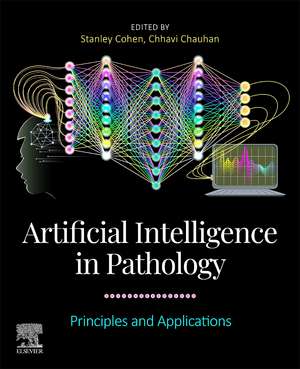Artificial Intelligence in Pathology: Principles and Applications
Editat de Chhavi Chauhan, Stanley Cohenen Limba Engleză Paperback – 15 noi 2024
This resource covers various aspects of the use of AI in pathology, including but not limited to the basic principles, advanced applications, challenges in the development, deployment, adoption, and scalability of AI-based models in pathology, the innumerous benefits of applying and integrating AI in the practice of pathology, ethical considerations for the safe adoption and deployment of AI in pathology.
- Discusses the evolution of machine learning in the field to provide a foundational background
- Addresses challenges in the development, deployment and regulation of AI in anatomic pathology
- Includes information on generative deep learning in digital pathology workflows
- Provides current tools and future perspectives
Preț: 740.62 lei
Preț vechi: 965.24 lei
-23% Nou
Puncte Express: 1111
Preț estimativ în valută:
141.73€ • 153.90$ • 119.06£
141.73€ • 153.90$ • 119.06£
Carte tipărită la comandă
Livrare economică 15-29 aprilie
Livrare express 15-21 martie pentru 96.29 lei
Preluare comenzi: 021 569.72.76
Specificații
ISBN-13: 9780323953597
ISBN-10: 032395359X
Pagini: 410
Dimensiuni: 191 x 235 x 25 mm
Greutate: 0.86 kg
Ediția:2
Editura: ELSEVIER SCIENCE
ISBN-10: 032395359X
Pagini: 410
Dimensiuni: 191 x 235 x 25 mm
Greutate: 0.86 kg
Ediția:2
Editura: ELSEVIER SCIENCE
Public țintă
Useful for academicians, pathology researchers, practitioners, clinicians, clinical diagnostics researchers, administrators, policymakers, and vendors in the digital pathology field.Higher leadership and administrators of academic and clinical practice centers
Cuprins
PART I PRINCIPLES
1. The evolution of machine learning
2. Basics of machine learning strategies
3. Overview of advanced neural network architectures
4. Complexity in the use of AI in anatomic pathology
5. Quantum Artificial Intelligence: Things to come
6. Dealing with data: strategies for pre-processing
7. Easing the Burden of Annotation in pathology
8. Digital path as a platform for primary diagnosis and augmentation via a deep learning
9. Challenges in the Development, Deployment, and Regulation of AI in Anatomic Pathology
10. Ethics of AI in Pathology: Current Paradigms and Emerging Issues
PART II APPLICATIONS
11. Image enhancement via AI
12. Artificial Intelligence and Cellular Segmentation in Tissue Microscopy Images
13. Precision medicine in digital pathology
14. Generative Deep Learning in Digital Pathology Workflows
15. Predictive image-based grading of human cancer
16. The interplay between tumor and immunity
17. Machine-based evaluation intra-tumoral heterogeneity and tumor-stromal interface
PART III OVERVIEW
18. The computer as digital pathology assistant
19. Neuromorphic computing, general AI, and the future of pathology
1. The evolution of machine learning
2. Basics of machine learning strategies
3. Overview of advanced neural network architectures
4. Complexity in the use of AI in anatomic pathology
5. Quantum Artificial Intelligence: Things to come
6. Dealing with data: strategies for pre-processing
7. Easing the Burden of Annotation in pathology
8. Digital path as a platform for primary diagnosis and augmentation via a deep learning
9. Challenges in the Development, Deployment, and Regulation of AI in Anatomic Pathology
10. Ethics of AI in Pathology: Current Paradigms and Emerging Issues
PART II APPLICATIONS
11. Image enhancement via AI
12. Artificial Intelligence and Cellular Segmentation in Tissue Microscopy Images
13. Precision medicine in digital pathology
14. Generative Deep Learning in Digital Pathology Workflows
15. Predictive image-based grading of human cancer
16. The interplay between tumor and immunity
17. Machine-based evaluation intra-tumoral heterogeneity and tumor-stromal interface
PART III OVERVIEW
18. The computer as digital pathology assistant
19. Neuromorphic computing, general AI, and the future of pathology
